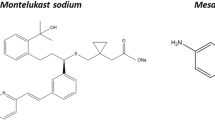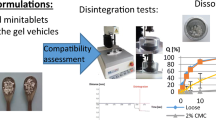Abstract
Purpose
Jellies for oral administration can be ingested whole or chewed, which can affect drug dissolution and absorption. In this study, we aimed to evaluate the effect of ingestion methods on drug absorption using a stick-type jelly containing a fixed-dose combination (FDC) of four drugs.
Methods
A stick-type jelly containing a FDC of four drugs was prepared and administered as a whole or in pre-disintegrated form to beagle dogs. The jellies were fabricated using xanthan gum, carrageenan, locust bean gum containing acetaminophen (AAP), chlorpheniramine maleate (CPM), dextromethorphan hydrobromide (DMH), and dl-methylephedrine hydrochloride (MEH).
Results
The early-phase dissolution rates at pH 1.2 were significantly higher in the pre-disintegrated form than in the whole jelly form, whereas no differences were observed after 45 min with dissolution rate of more than 90%. For AAP and CPM, areas under the time-concentration curve (AUCs) did not significantly change by the ingestion method. On the contrary, for DMH and MEH, AUCs in the whole jelly form increased by 1.24- and 1.46-fold, respectively, compared to those in the pre-disintegrated form, suggesting that the initial slower dissolution rate was favorable for absorption.
Conclusion
The effect of the degree of pre-disintegration of jellies on drug absorption was dependent on the type of drug used. Collectively, the FDC jelly can be an alternative dosage form to improve the drug acceptability in pediatric and geriatric patients.





Similar content being viewed by others
References
Allan GM, Arroll B (2014) Prevention and treatment of the common cold: making sense of the evidence. CMAJ 186:190–199
Almukainzi M, Araujo GLB, Löbenberg R (2019) Orally disintegrating dosage forms. J Pharm Investig 49:229–243
Barclay TG, Day CM, Petrovsky N, Garg S (2019) Review of polysaccharide particle-based functional drug delivery. Carbohydr Polym 221:94–112
Barrett B (2018) Viral upper respiratory infection. Integr Med. https://doi.org/10.1016/B978-0-323-35868-2.00018-9
Bertolini A, Ferrari A, Ottani A, Guerzoni S, Tacchi R, Leone S (2006) Paracetamol: new vistas of an old drug. CNS Drug Rev 12:250–275
Cho H-J (2020) Recent progresses in the development of hyaluronic acid-based nanosystems for tumor-targeted drug delivery and cancer imaging. J Pharm Investig 50:115–129
Dragan ES, Dinu MV (2019) Polysaccharides constructed hydrogels as vehicles for proteins and peptides: a review. Carbohydr Polym 225:115–210
El Maghraby GM, Elzayat EM, Alanazi FK (2012) Development of modified in situ gelling oral liquid sustained release formulation of dextromethorphan. Drug Dev Ind Pharm 38:971–978
Hanawa T, Watanabe A, Tsuchiya T, Ikoma R, Hidaka M, Sugihara M (1995) New oral dosage form for elderly patients: preparation and characterization of silk fibroin gel. Chem Pharm Bull (Tokyo) 43:284–288
Hanning SM, Lopez FL, Wong IC, Ernest TB, Tuleu C, Orlu Gul M (2016) Patient centric formulations for paediatrics and geriatrics: similarities and differences. Int J Pharm 512:355–359
Hasan N, Rahman L, Kim S-H, Cao J, Arjuna A, Lallo S, Jhun BH, Yoo J-W (2020) Recent advances of nanocellulose in drug delivery systems. J Pharm Investig 50:553–572
Julious SA, Debarnot CA (2000) Why are pharmacokinetic data summarized by arithmetic means? J Biopharm Stat 10:55–71
Kalantzi L, Reppas C, Dressman JB, Amidon GL, Junginger HE, Midha KK, Shah VP, Stavchansky SA, Barends DM (2006) Biowaiver monographs for immediate release solid oral dosage forms: acetaminophen (paracetamol). J Pharm Sci 95:4–14
Kasim NA, Whitehouse M, Ramachandran C, Bermejo M, Lennernäs H, Hussain AS, Junginger HE, Stavchansky SA, Midha KK, Shah VP, Amidon GL (2004) Molecular properties of WHO essential drugs and provisional biopharmaceutical classification. Mol Pharm 1:85–96
Kim SS (2014) The mini-cup jelly court cases: a comparative analysis from a food ethics perspective. J Agric Environ Ethics 27:735–748
Kim KH, Jun M, Lee MK (2020) Bioavailability of the common cold medicines in jellies for oral administration. Pharmaceutics 12:1073
Layek B, Mandal S (2020) Natural polysaccharides for controlled delivery of oral therapeutics: a recent update. Carbohydr Polym 230:115617
Liu J, Zhan X, Wan J, Wang Y, Wang C (2015) Review for carrageenan-based pharmaceutical biomaterials: favourable physical features versus adverse biological effects. Carbohydr Polym 121:27–36
Lopez FL, Ernest TB, Tuleu C, Gul MO (2015) Formulation approaches to pediatric oral drug delivery: benefits and limitations of current platforms. Expert Opin Drug Deliv 12:1727–1740
Meyyanathan SN, Rajan S, Muralidaharan S, Siddaiah MK, Krishnaraj K, Suresh B (2008) Formulation and evaluation of dextromethorphan hydrobromide sustained release tablets. Drug Deliv 15:429–435
Mikac UA, Sepe A, Baumgartner SA, Kristl J (2016) The influence of high drug loading in xanthan tablets and media with different physiological pH and ionic strength on swelling and release. Mol Pharm 13:1147–1157
Ministry of Food and Drug Safety of Republic of Korea (2019) Chapter 8. General Test Methods. In: Food Code.
Ministry of Food and Drug Safety of Republic of Korea (2019) The Korean pharmacopoeia, 12th edn
Miyazaki S, Takahashi A, Itoh K, Ishitani M, Dairaku M, Togashi M, Mikami R, Attwood D (2009) Preparation and evaluation of gel formulations for oral sustained delivery to dysphagic patients. Drug Dev Ind Pharm 35:780–787
Park BJ, Choi HJ, Moon SJ, Kim SJ, Bajracharya R, Min JY, Han H-K (2019) Pharmaceutical applications of 3D printing technology: current understanding and future perspectives. J Pharm Investig 49:575–585
Prajapati VD, Jani GK, Moradiya NG, Randeria NP, Nagar BJ (2013) Locust bean gum: a versatile biopolymer. Carbohydr Polym 94:814–821
Walker MJ, Colwell P, Craston D, Axford IP, Crane J (2012) Analytical strategy for the evaluation of a specific food choking risk, a case study on jelly mini-cups. Food Anal Methods 5:54–61
Zhang H, Zhang F, Yuan R (2019) Chapter 13. Applications of natural polymer-based hydrogels in the food industry. In: Chen H (ed) Hydrogels based on natural polymers, vol 1. Elsevier, London, pp 357–410
Zheng M, Zhou H, Wan H, Chen YL, He Y (2015) Effects of herbal drugs in Mahuang decoction and their main components on intestinal transport characteristics of Ephedra alkaloids evaluated by a Caco-2 cell monolayer model. J Ethnopharmacol 164:22–29
Acknowledgements
This research was funded by the Chong Kun Dang Pharm. Co. and in part by the National Research Foundation of Korea (NRF) funded by the Ministry of Science and ICT (2019R1A2C1006524 to Mi-Kyung Lee).
Author information
Authors and Affiliations
Corresponding authors
Ethics declarations
Conflict of interest
Mi-Kyung Lee received research grants from the CKD Pharm. Kyung Hee Han and Joong-Won Jeon are researchers at CKD Pharm. The funders had no role in the study design; in the collection, analyses, or interpretation of data; in the writing of the manuscript; or in the decision to publish the results.
Research involving human and animal participants
The study was conducted in accordance with the guidelines of the Declaration of Helsinki and approved by the Institutional Review Board of CKD Pharm (study number 03010-19001).
Additional information
Publisher's Note
Springer Nature remains neutral with regard to jurisdictional claims in published maps and institutional affiliations.
Rights and permissions
About this article
Cite this article
Han, K.H., Jeon, JW., Chae, YJ. et al. Effect of ingestion methods of jellies for oral administration on drug absorption in beagle dogs. J. Pharm. Investig. 51, 587–595 (2021). https://doi.org/10.1007/s40005-021-00535-x
Received:
Accepted:
Published:
Issue Date:
DOI: https://doi.org/10.1007/s40005-021-00535-x




